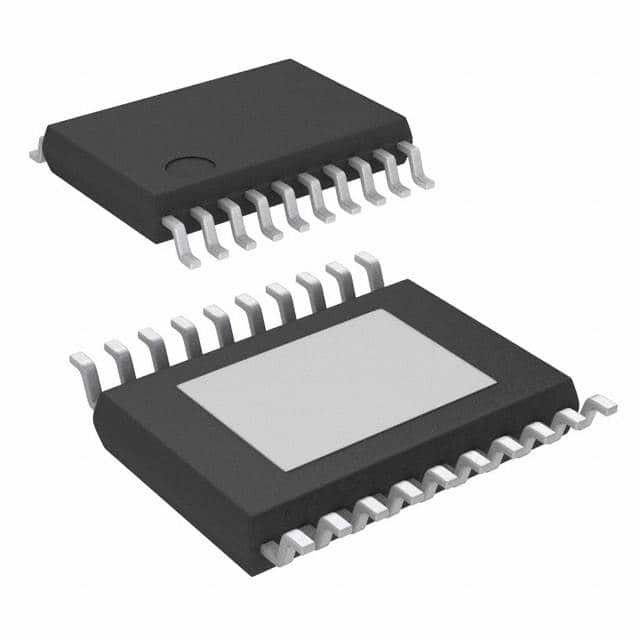Xem thông số kỹ thuật để biết chi tiết sản phẩm.

BQ24003PWPR
Product Overview
Category
BQ24003PWPR belongs to the category of integrated circuits (ICs) specifically designed for battery charging applications.
Use
This product is commonly used in portable electronic devices, such as smartphones, tablets, and wearable devices, to efficiently charge their batteries.
Characteristics
- High charging efficiency
- Compact size
- Low power consumption
- Wide input voltage range
- Overvoltage protection
- Thermal regulation
Package
BQ24003PWPR is available in a small 20-pin TSSOP (Thin Shrink Small Outline Package) package.
Essence
The essence of BQ24003PWPR lies in its ability to provide a reliable and efficient charging solution for various battery-powered devices.
Packaging/Quantity
This product is typically packaged in reels or tubes, with a quantity of 250 units per reel/tube.
Specifications
- Input Voltage Range: 4.35V - 6.45V
- Charging Voltage: 4.2V
- Maximum Charging Current: 1A
- Standby Current: <10µA
- Operating Temperature Range: -40°C to +85°C
Detailed Pin Configuration
- VBUS: Input voltage from USB port
- AC/DC: Input voltage from AC adapter
- GND: Ground reference
- STAT: Charging status indicator output
- PG: Power good indicator output
- TS: Thermistor input for thermal regulation
- ISET: Charging current setting resistor connection
- BAT: Battery positive terminal
- NTC: Negative temperature coefficient thermistor input
- PROG: Programming resistor connection
- EN/UVLO: Enable input/Undervoltage lockout
- CE: Charge enable input
- DPM: D+ pull-up resistor connection
- DPP: D- pull-up resistor connection
- USBP: USB data line D+
- USBN: USB data line D-
- VSS: Ground reference
- VDD: Supply voltage input
- TS/NTC: Thermistor or NTC selection
- TS2: Second thermistor input for dual-zone thermal regulation
Functional Features
- Constant Current (CC) Charging Mode: Provides a controlled charging current to the battery until a specified voltage is reached.
- Constant Voltage (CV) Charging Mode: Maintains a constant voltage across the battery terminals during the final stage of charging.
- Thermal Regulation: Monitors the temperature and adjusts the charging current accordingly to prevent overheating.
- Overvoltage Protection: Safeguards the battery by limiting the charging voltage to a safe level.
- Charge Enable Input: Allows external control over the charging process.
- Charging Status Indication: Provides an output signal indicating the charging status.
- Power Good Indication: Signals when the input power supply is within the acceptable range.
Advantages and Disadvantages
Advantages
- High charging efficiency ensures faster charging times.
- Compact size allows for integration into space-constrained devices.
- Low power consumption minimizes energy wastage.
- Wide input voltage range enables compatibility with various power sources.
- Overvoltage protection safeguards the battery from potential damage.
- Thermal regulation prevents overheating, ensuring safe charging.
Disadvantages
- Limited maximum charging current may not be suitable for high-capacity batteries.
- Lack of advanced features, such as wireless charging or fast charging protocols.
Working Principles
BQ24003PWPR operates based on a combination of constant current and constant voltage charging modes. Initially, it supplies a controlled charging current to the battery until a specified voltage is reached. Once the battery voltage reaches this level, the charger switches to a constant voltage mode to maintain a steady voltage across the battery terminals. The charging current is adjusted based on the temperature of the device to prevent overheating. Overvoltage protection ensures that the charging voltage does not exceed safe limits.
Detailed Application Field Plans
BQ24003PWPR finds extensive application in various portable electronic devices, including smartphones, tablets, smartwatches, and wireless earbuds. It is particularly suitable for devices with moderate battery capacities that require efficient and reliable charging.
Detailed and Complete Alternative Models
- BQ24004PWPR: Similar to BQ24003PWPR but with a higher maximum charging current of 1.5A.
- BQ24005PWPR: Offers additional features like thermal regulation and overvoltage protection, with a maximum charging current of 2A.
- BQ24006PWPR: Provides advanced charging capabilities, including fast charging protocols and wireless charging support, with a maximum charging current of 3A.
These alternative models offer increased charging currents and additional features, catering to different requirements and applications
Liệt kê 10 câu hỏi và câu trả lời thường gặp liên quan đến ứng dụng BQ24003PWPR trong giải pháp kỹ thuật
Sure! Here are 10 common questions and answers related to the application of BQ24003PWPR:
Question: What is the BQ24003PWPR?
Answer: The BQ24003PWPR is a highly integrated single-cell Li-Ion battery charger and system power path management device.Question: What is the input voltage range for the BQ24003PWPR?
Answer: The input voltage range is from 4.35V to 6.5V.Question: What is the maximum charging current supported by the BQ24003PWPR?
Answer: The maximum charging current is 1A.Question: Can the BQ24003PWPR charge multiple batteries simultaneously?
Answer: No, it is designed to charge a single-cell Li-Ion battery.Question: Does the BQ24003PWPR have overvoltage protection?
Answer: Yes, it has built-in overvoltage protection to prevent damage to the battery.Question: Can the BQ24003PWPR be used in portable devices?
Answer: Yes, it is suitable for use in portable devices such as smartphones, tablets, and wearable devices.Question: Does the BQ24003PWPR support USB charging?
Answer: Yes, it supports USB charging with a dedicated USB detection pin.Question: Is the BQ24003PWPR compatible with different battery chemistries?
Answer: No, it is specifically designed for Li-Ion batteries.Question: What is the purpose of the system power path management feature?
Answer: The system power path management allows the device to power the system directly from the input source while simultaneously charging the battery.Question: Does the BQ24003PWPR have thermal regulation?
Answer: Yes, it has built-in thermal regulation to prevent overheating during charging.
Please note that these answers are general and may vary depending on the specific implementation and configuration of the BQ24003PWPR in a technical solution.

